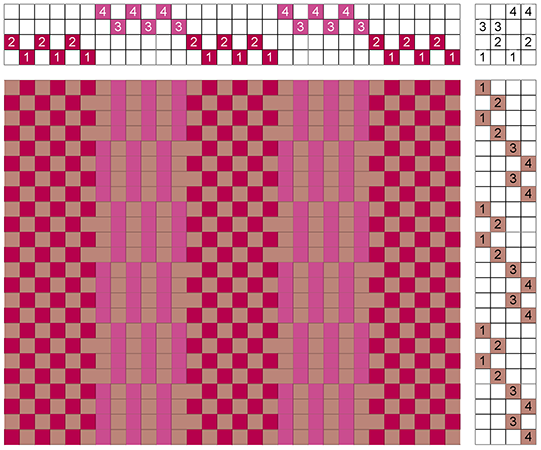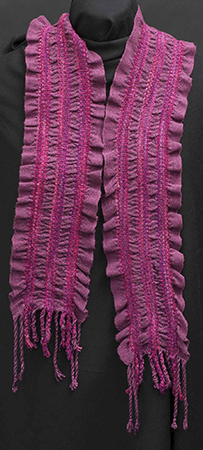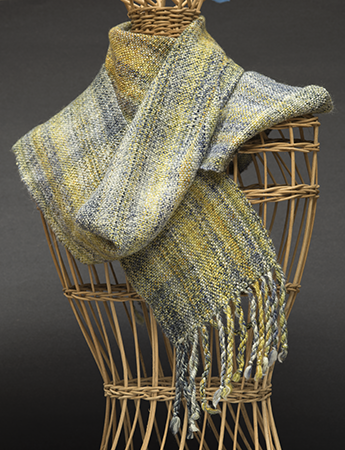Deflected Double Weave
Marcy Petrini
April 2019
In double weave, we weave two layers of cloth which can be joined on the loom to form a double cloth or a tube. In deflected double weave, the two layers are interlaced, causing the deflection; the technique can be woven for differential shrinking, by using a yarn for one layer that fulls more than the yarn in the other layer. Often more than 4 shafts are used, so the two layers are not restricted to plain weave. A few years ago, I wanted to weave a deflected double weave fabric, not to full it, but to understand how it works; to get started, I chose to adopt the pattern than Holly Brockman published in Fabrics that Go Bump (page 94). The bottom layer is plain weave on four shafts, interlacing and anchoring the floats of the top layer horizontally and vertically, forming motifs. Here is a close up of the fabric:

The ground warp and weft are 10/2 Tencel® from Just Our Yarns, from a past Convergence®; it is variegated in blues, greens, and yellows, called Great Lakes Sunrise. The overlayer is 20/2 silk from RedFish Dyeworks in blues. The draft is below; the drawdown doesn’t show the interlacing of the bottom layer, but the draft has the threading and treadling directions. The ground warp and weft are shown in green, the overlayer in blue.

Click here for the full-sized draft (a PDF will open a new window)
The ratio of top and bottom layers – here 4 / 6 – determines the number of threads in the float, so the sett is important; I used an 8-dent reed and I sleyed 2 per dent for the Tencel® and 4 treads in one dent for the silk. I liked the fabric and I thought that “one of those days” I will try it for differential shrinking. More recently, as I was thinking about puckering fabrics, I wondered: why not deflected double weave on 4 shafts? The ground fabric in the 8-shaft version I wove was plain weave on four shafts, which can be simplified to two shafts; the top layer could have floats anchored by plain weave, using the other two shafts. I am sure other people have had this idea, but it was easy enough to figure this out from scratch. Below is the draft of the fabric that I wove. The bottom layer was woven, as in the 8-shaft version, with 10/2 Tencel® (from Margaret Pittman, no longer available) variegated in reds; in the draft the warp is red, the weft is pink to show the intersection; the top layer is red Jaggerspun wool; in the draft, the warp is burgundy, the weft brown.

Click here for the full-sized draft (a PDF will open a new window)
I used the same ratio as for the 8-shaft version, 6 threads for the ground, 4 for the top layer and I sett the warp the same way in an 8-dent reed. Below on the left is the fabric off the loom, on the right after it was washed in hot water and hung to dry. There was about 40% shrinkage, so the two fabrics in the pictures are the same dimensions.
 |
 |
The back of the fabric before washing (below on the left) is pretty flat, but it becomes bumpy after washing (on the right).
 |
 |
A summary of the 4-shaft deflected double weave is in the Pictionary, downloadable as a pdf.
Happy weaving!
Please email comments and questions to
Weaving Ruffles
Marcy Petrini
March 2019
In the Spring 2019 issue of Shuttle Spindle & Dyepot (# 197), there is a wonderful article about Ann Richards and her collapse fabrics.
I have long been intrigued by three-dimensional textiles, but I have never systematically pursued them. Here and there I have dabbled to make some simple ones, projects that may be suitable for my teaching. One technique I have tried is to make ruffles.
A few Convergences® ago I found some stretchy yarn that I thought would be fun to weave. It is a 1% Lycra®, 99% cotton loop, close in size to 5/2 cotton, hand-dyed in wine and purple by Teresa Ruch and available in her booth.
To weave it, I wanted to have stripes of the Lycra® to make a sample scarf with ruffles; to figure how what the rest of the scarf should be, I tried yarns in cotton, wool and silk of approximately the same size as the Lycra®. The silk ended up giving me the results I was looking for: drape and not too much fulling so that the Lycra® could contract.
On my shelf I had a wine color 100% silk, Hana from ArtFibers which wrapped at 22 wpi. It is a bit smaller in grist than the Lycra®, but it had a wonderful hand and the colors went well together. I decided to use it and sett it at 15 epi, while the Lycra® would be sett at 12 epi.
I divided the 6” width into: 1” silk, 1” Lycra®, 0.5” silk, 1” Lycra®, 0.5” silk, 1” Lycra®, 1” silk.
To weave it, I used plain weave for the silk, threaded on shafts 1 and 2, and ribbing for the Lycra®, threaded on 3 and 4, as shown below. The weft was the same Hana silk, even though I used I different color in the drawdown, so I could see the structure.

Click here for the full-sized draft (a PDF will open a new window)
To avoid floats where I didn’t want them, the structure required an even number of threads, so I adjusted the width slightly; the 1” of silk was 14 treads, and the 0.5” was 8 threads, so the total was just a threads short (44 threads rather than 45 for the silk).
The bouts of Lycra® were tension separately with weights since the loom I planned on using doesn’t have a second beam.
In sleying, I didn’t want to bunch up the silk, so I chose a 15 dent reed, sleying the silk 1 per dent, and sleying the Lycra® 1, 1, 1, skip 1.
Here is a photo of the finished scarf. For didactic reasons, I chose not to trim the considerably longer silk fringe. Of course, for a finished project, I would trim them all to the same length, but I would also leave longer fringe for the Lycra®. Perhaps beads at the end of the fringe could stretch the Lycra® so extra length may not be necessary.

Not surprisingly, there was some take up and a lot of shrinkage. The Lycra® didn’t crimp much until it was washed. Length-wise the take up was approximately 10%, but the shrinkage was nearly 34%. I had planned about 30% take-up and 50% shrinkage, so the final length, almost 70” was plenty long. In the width, the take-up was 8% and the shrinkage 5%. I hope this inspires you to try some Lycra® in your weaving!
Happy weaving!
Please email comments and questions to
More Rigid Heddle Weaving
Marcy Petrini
February 2019
With my first two warps on the Flip loom, described in the January 2019 blog, I learned a bit about tension on the rigid heddle. Given that the warp cannot be tensioned very tightly, I thought that warping with a woolen handspun should work.
Recently I had spun a 3.5 oz braid of 65% super-wash merino and 35% silk called Starry Night, a gift from a friend; the colors ranged from blue-black to yellow and gold. I spun it with no project in mind, split in half for a two-ply, letting the colors fall where they may. The yarn wrapped at 24 epi, so it was perfect for my 12-dent rigid heddle.
I calculated that for a scarf about 7” wide and 100” long on the loom (allowing for 16” loom waste), I would have enough for warp and weft. And here is the scarf!

But when I was spinning the fiber and then weaving with the yarn, I was reminded that I usually don’t use super-wash merino; combined with the silk, the scarf has a good hand and drape, but there is an underlying slickness that reminds me of synthetic yarns.
When it was first introduced, I was very enthusiastic about super-wash merino, as were many people, but when it came to buy it, I always seemed to choose something else. I sometimes thought that super-wash really didn’t feel like merino, but I dismissed the thought.
Just as I was finishing weaving the scarf, I read the December 2018 issue of Ply magazine and I discovered that I am not the only who is not crazy about super-wash merino. Furthermore, in a great article, Julie-Anne Gandier discusses the processes resulting in super-wash and, totally new to me, the environmental impact of those processes – of course! Depending on the process, there can be lots of water used, chlorinated waste, and a plastic-like coating to the fiber itself (no wonder it reminds of synthetic yarns!). She does say that alternatives are being developed to counteract the environmental impact. Whether you like super-wash wool or not, I highly recommend her article.
Other fibers and handspuns are in my stash, so they will have to find their way to my rigid heddle.
Happy weaving!
Please email comments and questions to
Rigid Heddle Weaving
Marcy Petrini
January 2019
 I love plain weave, especially weaving it off with variegated, textured yarns, and I like to experiment with the color interactions. I can weave it on my floor loom, so investing in a rigid heddle loom didn’t seem to make sense, especially since I had bought one in the late 80s which for me turned out to be slower to dress than my floor loom.
I love plain weave, especially weaving it off with variegated, textured yarns, and I like to experiment with the color interactions. I can weave it on my floor loom, so investing in a rigid heddle loom didn’t seem to make sense, especially since I had bought one in the late 80s which for me turned out to be slower to dress than my floor loom.
But when I saw how quickly my friend and colleague Kathy Perito dressed her Schacht Cricket, I started to think that it would great to weave by the fire in the evenings, with a glass of wine and a cat or two, chatting with my husband. After talking with Kathy, this is what I asked Santa Clause:
- A Schacht Flip loom because it can be expanded to two heddles (in case I get ambitious) and it can also be folded
- A stand so I wouldn’t need a table, and I could transport the loom anywhere.
- A heddle of 12 dents/inch, for now, because I don’t have much yarn that I would sett more openly; with the Flip loom there is a choice of heddle sett.
The loom arrived and in less than 2 hours, it was assembled, placed on its stand, dressed, threaded and ready to weave! I must admit that a lot of the assembling was done by my husband Terry who has a tendency to take over (maybe because he knows I can be a klutz).
I chose a bright green 3/2 cotton, which is perfect sett at 12 epi for plain weave. For weft, I found in my stash a fat textured, multicolored chenille yarn with a binder of black hair yarn around the chenille; the yarn, Trendsetter Yarns Savvy, wraps at 5 wpi, shown below.

With a yarn that thick normally we would sett the warp more openly to accommodate the weft, but since this yarn is basically chenille, opening the sett wasn’t necessary. The conventional wisdom is to treat the chenille as if the fuzzy hair isn’t there, using the core as a guide. I have successfully sett chenille warps closely and I have knitted chenille with much smaller needles than the yarn size would seem to need, as it was recommended to me many years ago.
My sampler scarf was 6” wide with a warp two yards long; it took two hours to complete, including hemming on the loom at the start and at the end with the warp thread. The scarf was light and drapey, despite the fat weft and the dense warp.
I washed the scarf on my front loader machine on the “hand wash” cycle which I use for all of my handwoven scarves and shawls, including silk, even though the directions for the weft yarn say that dry cleaning is recommended. Coming off the washer, I didn’t notice any problems, but the scarf was very wet; since the weft is 62% acrylic and 38% polyester, I saw no harm in drying it in the dryer at very low heat.
The harm was in the disaster that ensued! Warp ends bunched and the weft inch wormed, as shown below:

Every mistake is an opportunity to learn. I didn’t think that the warp bunching was the result of the sett; I hypothesized that I didn’t beat the weft enough; the warp, then, had lots of wiggle room which was accelerated while tumbling in the drier. I think that if I hadn’t tumble-dried it, the bunching and inch-worming would have occurred with use – I have had that happen before.
Looking back at it, I did find it hard to beat with the rigid heddle, but since my natural beat is pretty hard, I didn’t think that the light beat was necessarily a bad thing. The weft beat is always related to the warp tension and, as I read and as confirmed by Kathy, it’s harder to keep a firm tension on a light-weight, portable rigid heddle loom than on a solid floor loom. On my floor looms, I adjust the warp tension according to the beat I want the fabric to have, but on the rigid heddle loom there isn’t much wiggle room.
But how do you translate the adjustment to make on the beat, given a soft tension on a light loom? Experience!
To prove my hypothesis that it was the beat that caused the problem, I put a new warp on the Flip loom, with the same yarn and woven with the same weft; this time I beat it with a tapestry beater. The fabric is a lot denser and not as drapable, but there is no inch-worming and minimal warp bunching after washing the same way.
For a true experiment, I should have dried it in the drier, but I was afraid that the fabric would become denser still. But it is pretty convincing that the beat was the culprit.

So, on warp #3, I am practicing my beat, trying to keep it even by measuring the ppi often. There will be a follow up report!
Happy weaving!
Please email comments and questions to
Lacey Stripes
Marcy Petrini
December, 2018
I was thinking of possible interesting structures that I may add to the Pictionary, when I remembered a fabric I wove a long time ago, so long that I actually wove it with crochet cotton because there were no yarn shops in town and my mail order yarn was back ordered.


Unfortunately, I don’t remember where I learned this, but my notes say that it was a combination structure, combining a pointed twill with plain weave. Looking at it now, I think I would classify it as a treadling method because the resulting fabric produces lacey stripes and stripes of plain weave.
Unlike classical woven laces, where each block can generally weave either floats or plain weave, in this structure each area can only weave plain weave or the lacey stripe. Furthermore, to show case the lacey stripes better, the sleying is specific.
As shown in the drawdown below, the plain weave is threaded 2, 3, shown in brown, and repeated as long as we wish. The lacey stripes, shown in red, are made up of two units: 2, 1, 2 (A) and 3, 4, 3 (B); the two alternates for as many repeats as desired, with a balancing A unit at the end of the repeat; the following plain weave, then, starts on shaft 3. In the lacey units there are both warp and weft floats.

Click here for the full-sized draft (a PDF will open a new window)
Sleying is easiest if the denting of the reed is the same as the tabby sett for the warp yarn; then the stripe threaded 2, 3 is sleyed 1 per dent. The sleying for the lacey units is:
- 2, 1, 2 in one dent
- Skip 2 dents
- 3, 4, 3 in one dent
- Skip 2 dents.
From the drawdown we see that the treadling only requires 4 treadles since there are two shots on 1 & 3 for each repeat; similarly, there are two shots for 4 & 2; using the 6 treadles usually available with a 4-shaft loom makes the treadling easier and more efficient.
After wet finishing, the lacey stripes are more obvious as can be seen by the picture of the cloth, while the drawdown shows the actual structure of the fabric.
Next time you want to weave lace, try stripes! A Pictionary entry (click here) has been added for this structure.
Happy weaving!
Please email comments and questions to
This blog has been clarified since the initial posting. Thank you to Kathy Perito to bring the inconsistencies to my attention.
